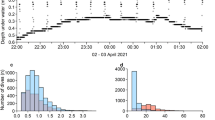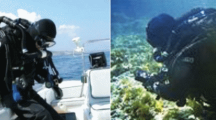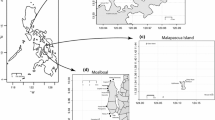Abstract
Effective exploration of mesophotic coral ecosystems (MCEs) has been limited primarily by available technology. Although research targeting MCEs led to the development of the first electronically controlled, closed-circuit rebreather in the late 1960s to the early 1970s, it wasn’t until the 1990s that the technology was utilized extensively for MCE research. Over the years, diving techniques and technologies have gradually advanced from conventional SCUBA to open-circuit, mixed-gas diving to closed-circuit rebreathers, each progressively increasing diver safety and bottom time at depth. Over the past decade, the application of closed-circuit rebreathers for use in MCE research has increased dramatically, enabling research activities that are impractical or impossible using other technologies. When conducting advanced diving operations to study MCEs, many logistical and practical considerations must be taken into account. Trained and experienced divers and support personnel are required and must have access to appropriate equipment. Contingencies both during dives (e.g., bailout options) and in response to emergencies must be clearly defined and understood. Insights and guidelines for conducting MCE research using rebreathers are recommended based on over three decades of field experience. As scientific diving programs at more institutions continue to establish support for advanced technical diving operations, the application of this approach to MCE research will help scientists conduct work efficiently and safely.
Access this chapter
Tax calculation will be finalised at checkout
Purchases are for personal use only
Similar content being viewed by others
References
American Academy of Underwater Sciences [AAUS] (2016) The American Academy of Underwater Sciences standards for scientific diving. AAUS, Dauphin Island
Armstrong RA, Pizarro O, Roman C (2019) Underwater robotic technology for imaging mesophotic coral ecosystems. In: Loya Y, Puglise KA, Bridge TCL (eds) Mesophotic coral ecosystems. Springer, New York, pp 973–988
Bean JW (1945) Effects of oxygen at increased pressure. Physiol Rev 25:1–147
Bennett PB (1982) Inert gas narcosis. In: Bennett PB, Elliot DH (eds) The physiology and medicine of diving and compressed air work. Balliere-Tindall, London, pp 239–261
Bennett PB (1990) Inert gas narcosis and HPNS. In: Bove AA, Davis JC (eds) Diving medicine, 2nd edn. W.B. Saunders Company, Philadelphia, pp 69–81
Bozanic JE (2002) Mastering rebreathers. Best Publishing Company, Flagstaff
Clark JM (1982) Oxygen toxicity. In: Bennett PB, Elliot DH (eds) The physiology and medicine of diving and compressed air work. Balliere-Tindall, London, pp 200–238
Colin P (1997) Update on the science lung II. In: B.P. Bishop Museum exploration and discovery: the coral-reef twilight zone, Palau ‘twilight zone’ expedition, 4–19 May 1997. http://www.bishopmuseum.org/research/treks/palautz97/sl2.html. Accessed 29 July 2017
Collette B, Earle SA (eds) (1972) Results of the Tektite Project: ecology of coral reef fishes. Los Angeles Co Nat Hist Mus Sci Bull 14:1–180
Doolette DJ, Gault KA, Gerth WA (2015) Decompression from He-N2-O2 (trimix) bounce dives is not more efficient than from He-O2 (heliox) bounce dives. Navy Experimental Diving Unit, Panama City
Gilliam B, Taylor LH (1993) A brief history of mixed gas diving. In: Mount T, Gilliam B (eds) Mixed gas diving: the ultimate challenge for technical divers. Watersports Publishing, San Diego, pp 15–50
Gilliam B, von Mair R (1992) Deep diving: an advanced guide to physiology, procedures and systems. Watersport Publishing, San Diego
Gilmore RG Jr (2016) You can’t catch a fish with a robot. Gulf Carib Res 27(1):ii–xiv
Gray AE, Williams ID, Stamoulis KA, Boland RC, Lino KC, Hauk BB, Leonard JC, Rooney JJ, Asher JM, Lopes KH Jr (2016) Comparison of reef fish survey data gathered by open and closed circuit SCUBA divers reveals differences in areas with higher fishing pressure. PLoS ONE 11(12):e0167724
Gurr K (2010) Technical diving from the bottom up., updated edn. Kevin Gurr, UK
Hall H (1990) The sound of silence. Ocean Realm Fall:12–13
Hamilton RW (1990) Technology inspired: the closed circuit rebreather. aquaCORPS 2:10–14
Hamilton RW, Pence DF, Kesling DE (eds) (1999) Assessment and feasibility of technical diving operations for scientific exploration. American Academy of Underwater Sciences, Nahant
Hanlon RT, Hixon RF, Hendrix JP Jr, Forsythe JW, Sutton TE, Cross MR, Dawson R, Booth L (1982) The application of closed circuit scuba for biological observations. In: Blanchard J, Mair J, Morrison I (eds) Proceedings of the sixth International Scientific Symposium of CMAS, Proceedings of the Diving Science Symposium. National Environmental Research Council, London, pp 43–52
Heinerth P (1989) Plant equipment, underwater propulsion systems, and dive setup procedures. In: Stone WC (ed) The Wakulla Springs project. U.S. Deep Caving Team, Derwood, pp 60–69
Hinderstein L, Marr JCA, Martinez FA, Dowgiallo MJ, Puglise KA, Pyle RL, Zawada DG, Appeldoorn R (2010) Theme section on “Mesophotic coral ecosystems: characterization, ecology, and management.” Coral Reefs 29(2):247–251
Kindwall EP (1990) A short history of diving and diving medicine. In: Bove AA, Davis JC (eds) Diving medicine, 2nd edn. W.B. Saunders Company, Philadelphia, pp 1–8
Kosaki R, Pyle RL, Boland R, McFall G, Gleason K (2010) Technical diving used for mesophotic coral ecosystem characterization in the Papahānaumokuākea Marine National Monument. Paper presented at the 29th American Academy of Underwater Sciences Scientific Symposium, Ala Moana Hotel, Honolulu, 25–27 March 2010
Lafay V, Barthelemy P, Comet B, Frances Y, Jammes Y (1995) ECG changes during the experimental human dive HYDRA 10 (71 atm/7,200 kPa). Undersea Hyperb Med 22(1):51–60
Lambertsen CJ (1978) Effects of hyperoxia on organs and their tissues. In: Robin ED (ed) Extrapulmonary manifestations of respiratory disease. Lung biology in health and disease, vol 8. Marcel Dekker, New York, pp 239–303
Lang MA, Smith NE (eds) (2006) Proceedings of the Advanced Scientific Diving Workshop. February 23–24, 2006. Smithsonian Institution, Washington, DC
Lehnert H, Fischer H (1999) Distribution patterns of sponges and corals down to 107 m off North Jamaica. Mem-QLD Mus 44:307–316
Lindfield SJ, Harvey ES, McIlwain JL, Halford AR (2014) Silent fish surveys: bubble-free diving highlights inaccuracies associated with scuba-based surveys in heavily fished areas. Methods Ecol Evol 5(10):1061–1069
Lobel PS (2001) Fish bioacoustics and behavior: passive acoustic detection and the application of a closed-circuit rebreather for field study. Mar Technol Soc J 35:19–28
Lopes KH Jr (2017) Effects of open circuit SCUBA exhaust on reef fish surveys in the Main Hawaiian Islands. Thesis, University of Hawaiʻi at Hilo
Menduno M (1991a) What is technical diving. technicalDIVER 2.2:3
Menduno M (1991b) Technically speaking. aquaCORPS 3:45
Mount T, Gilliam B (eds) (1993) Mixed gas diving: the ultimate challenge for technical divers. Watersports Publishing, San Diego
Nemeth RS, Smith TB, Blondeau, J, Kadison, E, Calnan, JM, Gass J (2008) Characterization of deep water reef communities within the marine conservation district, St. Thomas, US Virgin Islands. Final report submitted to the Caribbean Fisheries Management Council (CFMC/NOAA), St. Thomas, US Virgin Islands
Norro A (2016) The closed circuit rebreather (CCR): is it the safest device for deep scientific diving? Underw Technol 34(1):31–38
Palmer R (ed) (1990) Underwater expeditions, 3rd edn. Expedition Advisory Centre, London
Parrish FA, Pyle RL (2002) Field comparison of open-circuit scuba to closed-circuit rebreathers for deep mixed-gas diving operations. Mar Technol Soc J 36(2):13–22
Pence DF, Pyle RL (2002) University of Hawaii dive team completes Fiji deep reef fish surveys using mixed-gas rebreathers. SLATE April:1–3
Pyle RL (1991) Rare and unusual marines: so many fish, so little time. Freshw Mar Aquar 14(4):42–44
Pyle RL (1992a) The twilight zone. aquaCORPS: Mix 3(1):19
Pyle RL (1992b) Deep reef set. aquaCORPS: Mix 3(1):17–21
Pyle RL (1996a) The twilight zone. Nat Hist 105(11):59–62
Pyle RL (1996b) Section 7.9. Multiple gas mixture diving, Tri-mix. In: Flemming NC, Max MD (eds) Scientific diving: a general code of practice, 2nd edn. United Nations Educational, Scientific and Cultural Organization (UNESCO), and Scientific Committee of the World Underwater Federation (CMAS), Paris, pp 77–80
Pyle RL (1996c) How much coral reef biodiversity are we missing? Glob Biodivers 6(1):3–7
Pyle RL (1996d) A learner’s guide to closed circuit rebreather diving. In: Richardson D, Menduno M, Shreeves K (eds) Proceedings of the Rebreather Forum 2.0, 26–28 September, 1996, Redondo Beach, p P45–P67
Pyle RL (1996e) Section 11.16. Therapy in the absence of a recompression chamber (in part). In: Flemming NC, Max MD (eds) Scientific diving: a general code of practice, 2nd edn. United Nations Educational, Scientific and Cultural Organization (UNESCO), Paris; and Scientific Committee of the World Underwater Federation (CMAS), Paris, pp 160–161
Pyle RL (1998) Chapter 7. Use of advanced mixed-gas diving technology to explore the coral reef “twilight zone”. In: Tanacredi JT, Loret J (eds) Ocean pulse: a critical diagnosis. Plenum Press, New York, pp 71–88
Pyle RL (1999a) Mixed-gas, closed-circuit rebreather use for identification of new reef fish species from 200–500 fsw. In: Hamilton RW, Pence DF, Kesling DE (eds) Assessment and feasibility of technical diving operations for scientific exploration. American Academy of Underwater Sciences, Nahant, pp 53–65
Pyle RL (1999b) Keeping up with the times: application of technical diving practices for in-water recompression. In: Kay E, Spencer MP (eds) Inwater recompression: the forty eighth workshop of the undersea and hyperbaric medical society. Undersea and Hyperbaric Medical Society and Diver’s Alert Network, pp 74–88
Pyle RL (2000) Assessing undiscovered fish biodiversity on deep coral reefs using advanced self-contained diving technology. Mar Technol Soc J 34(4):82–91
Pyle RL (2002) Insights on deep bounce dive safety from the technical diving community. Proceedings of the16th Meeting of the United States-Japan Cooperative Programs on Natural Resources (UJNR), 1–3 November 2001, East-West Center, Honolulu, pp 47–53
Pyle RL (2010) A learner’s guide to closed-circuit rebreather operations: twelve years on. In: Gurr K (ed) Technical diving from the bottom up, updated edn. Kevin Gurr, UK
Pyle RL (2016) Rebreather evolution in the foreseeable future. In: Pollock NW, Sellers SH, Godfrey JM (eds) Rebreathers and scientific diving, Proceedings of NPS/NOAA/DAN/AAUS February 16–19, 2015 Workshop. Wrigley Marine Science Center, Catalina Island, pp 40–65
Pyle RL, Youngblood D (1997) In-water recompression as an emergency field treatment of decompression illness (Revised). SPUMS J 27(3):154–169
Pyle RL, Boland R, Bolick H, Bowen B, Bradley CJ, Kane C, Kosaki RK, Langston R, Longenecker K, Montgomery AD, Parrish FA, Popp BN, Rooney J, Smith CM, Wagner D, Spalding HL (2016a) A comprehensive investigation of mesophotic coral ecosystems in the Hawaiian Archipelago. PeerJ 4:e2475
Pyle RL, Lobel P, Tomoleoni J (2016b) The value of closed-circuit rebreathers for biological research. In: Pollock NW, Sellers SH, Godfrey JM (eds) Rebreathers and scientific diving, Proceedings of NPS/NOAA/DAN/AAUS February 16–19, 2015 Workshop. Wrigley Marine Science Center, Catalina Island, pp 120–134
Rowley SJ (2014) Refugia in the ‘twilight zone:’ discoveries from the Philippines. Mar Biol 2:16–17
Sale PF (ed) (1991) The ecology of fishes on coral reefs. Academic, New York
Sellers SH (2016) Overview of rebreathers in scientific diving 1998–2013. In: Pollock NW, Sellers SH, Godfrey JM (eds) Rebreathers and scientific diving, Proceedings of NPS/NOAA/DAN/AAUS February 16–19, 2015 Workshop. Wrigley Marine Science Center, Catalina Island, pp 5–39
Sherman C, Appeldoorn R, Carlo M, Nemeth M, Ruíz H, Bejarano I (2009) Use of technical diving to study deep reef environments in Puerto Rico. In: Pollock NW (ed) Diving for science 2009, Proceedings of the American Academy of Underwater Sciences 28th Symposium. American Academy of Underwater Sciences, Dauphin Island, pp 58–65
Somers L (1993) Looking ahead: mixed gas in scientific diving. In: Mount T, Gilliam B (eds) Mixed gas diving: the ultimate challenge for technical divers. Watersports Publishing, San Diego, pp 321–333
Starck WA II (1973) New diving technology for marine scientists. Aust Nat Hist 17:181
Starck WA II, Starck JD (1972) From the Bahamas to Belize: probing the deep reef’s hidden realm. Natl Geogr 149(12):867–886
Stone WC (1989a) Deep cave diving: physiological factors. In: Stone WC (ed) The Wakulla Springs project. U.S. Deep Caving Team, Derwood, pp 25–53
Stone WC (1989b) Life support research. In: Stone WC (ed) The Wakulla Springs project. U.S. Deep Caving Team, Derwood, pp 95–111
Stone WC (1990) Exploring underwater with a failsafe diving rebreather. Sea Technol 1990(12):17–23
Tomoleoni JA, Weitzman BP, Young C, Harris M, Hatfield BE, Kenner M (2012) Closed-circuit diving techniques for wild sea otter capture. In: Steller D, Lobel L (eds) Diving for science 2012, Proceedings of the American Academy of Underwater Sciences 31st Symposium. American Academy of Underwater Sciences, Dauphin Island, pp 193–199
Tzimoulis P (1970) 300 feet on computerized scuba. Skin Divers 19(9):28–33
Wicklund RI (2011) Eyes in the sea: adventures of an undersea pioneer. Mariner Publishing, Buena Vista
Yarbrough OD, Welham W, Brinton EJ, Behnke AR (1947) Symptoms of oxygen poisoning and limits of tolerance at rest and at work. Nav Exp Diving Unit Rep 01-47
Acknowledgments
I am extremely grateful to the many talented and insightful divers who have trained me, worked and dived with me, and shared their helpful insights in developing these protocols over the years. In particular, I thank William C. Stone, Sonia J. Rowley, Mike Rowley, Randall K. Kosaki, Brian D. Greene, John L. Earle, John E. Randall, Joseph Dituri, Joshua Copus, Ken Longenecker, Ross Langston, and Roger A. Pfeffer. Research involving the use of rebreathers that facilitated the development of the protocols described herein has been supported by NOAA, the Association for Marine Exploration, Bishop Museum, Poseidon Diving Systems, Seaver Institute, Ocean Classrooms, and the Systematics Association.
Author information
Authors and Affiliations
Corresponding author
Editor information
Editors and Affiliations
Rights and permissions
Copyright information
© 2019 Springer Nature Switzerland AG
About this chapter
Cite this chapter
Pyle, R.L. (2019). Advanced Technical Diving. In: Loya, Y., Puglise, K., Bridge, T. (eds) Mesophotic Coral Ecosystems. Coral Reefs of the World, vol 12. Springer, Cham. https://doi.org/10.1007/978-3-319-92735-0_50
Download citation
DOI: https://doi.org/10.1007/978-3-319-92735-0_50
Published:
Publisher Name: Springer, Cham
Print ISBN: 978-3-319-92734-3
Online ISBN: 978-3-319-92735-0
eBook Packages: Earth and Environmental ScienceEarth and Environmental Science (R0)




